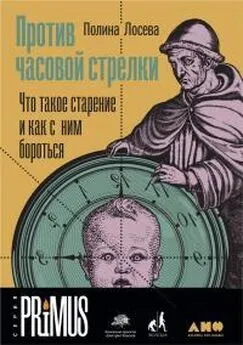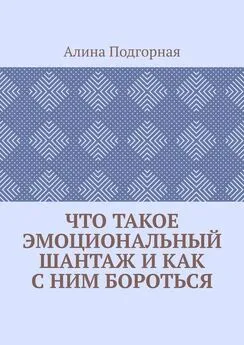Полина Лосева - Против часовой стрелки. Что такое старение и как с ним бороться
- Название:Против часовой стрелки. Что такое старение и как с ним бороться
- Автор:
- Жанр:
- Издательство:Альпина нон-фикшн
- Год:2020
- Город:Москва
- ISBN:978-5-0013-9314-6
- Рейтинг:
- Избранное:Добавить в избранное
-
Отзывы:
-
Ваша оценка:
Полина Лосева - Против часовой стрелки. Что такое старение и как с ним бороться краткое содержание
В своей книге биолог и научный журналист Полина Лосева выступает в роли адвоката современной науки о старении и рассказывает о том, чем сегодня занимаются геронтологи и как правильно интерпретировать полученные ими результаты. Кто виноват в том, что мы стареем? Что может стать нашей защитой от старости: теломераза или антиоксиданты, гормоны или диеты? Биологи пока не пришли к единому ответу на эти вопросы, и читателю, если он решится перейти от размышлений к действиям, предстоит сделать собственный выбор.
Эта книга станет путеводителем по современным теориям старения не только для биологов, но и для всех, кому интересно, как помочь своему телу вести неравную борьбу со временем.
Против часовой стрелки. Что такое старение и как с ним бороться - читать онлайн бесплатно ознакомительный отрывок
Интервал:
Закладка:
309
См. п. 157.
310
Liu H.-H. & Li J.-J. Aging and dyslipidemia: a review of potential mechanisms // Ageing Research Reviews. 2015 Jan; 19: 43–52.
311
Rudman D. et al. Effects of human growth hormone in men over 60 years old // NEJM.. 1990 Jul; 323 (1): 1–6.
312
Liu H. et al. Systematic review: the safety and efficacy of growth hormone in the healthy elderly // Annals of Internal Medicine. 2007 Jan; 146 (2): 104–115.
313
Bartke A. Growth hormone and aging: A challenging controversy // Clinical Interventions in Aging.. 2008 Dec; 3 (4): 659–665.
314
Horstman A. M., Dillon E. L., Urban R. J., Sheffield-More M. The role on androgens and estrogens on healthy aging and longevity // The Journals of Gerontology: Series A. 2012 Nov; 67 (11): 1140–1152.
315
Miller W. L. & Auchus R. J. The molecular biology, biochemistry, and physiology of human steroidogenesis and its disorders // Endocrinology Reviews. 2011 Feb; 32 (1): 81–151.
316
См. п. 82.
317
De Arellano M. L. B. et al. Sex differences in the aging human heart: decreased sirtuins, pro-inflammatory shift and reduced anti-oxidative defense // Aging. 2019 Apr; 11 (7): 1918–1933.
318
Kozminski M. A. & Bloom D. A. A brief history of rejuvenation operations // The Journal of Urology. 2012 Mar; 187 (3): 1130–1134.
319
Stambler A. The unexpected outcomes of anti-aging rejuvenation, and life extensions studies: an origin of modern therapies // Rejuvenation Research. 2014 Jun; 17 (3): 297–305.
320
См. п. 157.
321
Stanworth R. D. & Jones T. H. Testosterone for the aging male; current evidence and recommended practice // Clinical Interventions in Aging. 2008 Mar; 3 (1): 25–44.
322
Basaria S. et al. Adverse events associated with testosterone administration // NEJM. 2010 Jul; 363: 109–122.
323
Jayasena C. N., Alkaabi F. M., Liebers C. S., Handley T., Franks S., Dhillo W. S. A systematic review of randomized controlled trials investigating the efficacy and safety of testosterone therapy for female sexual dysfunction in postmenopausal women // Clinical Endocrinology. 2018 Nov; 90 (3): 391–414.
324
Garratt M. et al. 17‐α estradiol ameliorates age‐associated sarcopenia and improves late‐life physical function in male mice but not in females or castrated males // Aging Cell. 2019 Feb; 18 (2): e12920.
325
Conese M., Carbone A., Beccia E., Angiolillo A. The Fountain of youth: a tale of parabiosis, stem cells, and rejuvenation // Open Medicine. 2017 Jul; 12 (1): 376.
326
Conboy M. J., Conboy I. M., Rando T. A. Heterochronic parabiosis: historical perspective and methodological considerations for studies of aging and longevity // Aging Cell. 2013 Mar; 12 (3): 525–530.
327
Wright D. E. et al. Physiological migration of hematopoietic stem and progenitor cells // Science. 2001 Nov; 294 (5548): 1933–1936.
328
Balsam L. B. et al. Haematopoietic stem cells adopt mature haematopoietic fates in ischaemic myocardium // Nature. 2004 Mar; 428: 668–673.
329
Eggan K., Jurga S., Gosden R., Min I. M., Wagers A. J. Ovulated oocytes in adult mice derive from non-circulating germ cells // Nature. 2006 Jun; 441: 1109–1114.
330
Salpeter S. J., Khalaileh A., Weinberg-Corem N., Ziv O., Glaser B., Dor Y. Systemic Regulation of the Age-Related Decline of Pancreatic β-Cell Replication // Diabetes. 2013 Aug; 62 (8): 2843–2848.
331
Añón-Hidalgo J. et al. Circulating GDF11 levels are decreased with age but are unchanged with obesity and type 2 diabetes // Aging. 2019 Mar; 11 (6): 1733–1744.
332
Sinha M. et al. Restoring systemic GDF11 levels reverses age-related dysfunction in mouse skeletal muscle // Science. 2014 May; 344 (6184): 649–652.
333
Brack A. S. et al. Increased Wnt signaling during aging alters muscle stem cell fate and increases fibrosis // Science. 2007 Aug; 317 (5839): 807–810.
334
Loffredo F. S. et al. Growth differentiation factor 11 is a circulating factor that reverses age-related cardiac hypertrophy // Cell. 2013 May; 153 (4): 828–839.
335
Katsimpardi L. et al. Vascular and neurogenic rejuvenation of the aging mouse brain by young systemic factors // Science. 2014 May; 344 (6184): 630–634.
336
Egerman M. A. et al. GDF11 increases with age and inhibits skeletal muscle regeneration // Cell Metabolism. 2015 Jul; 22 (1): 164–174.
337
Elabd C. et al. Oxytocin is an age-specific circulating hormone that is necessary for muscle maintenance and regeneration // Nature Communications. 2014 Jun; 5: 4082.
338
Castellano J. M. et al. Human umbilical cord plasma proteins revitalize hippocampal function in aged mice // Nature. 2017 Apr; 544: 488–492.
339
Villeda S. A. et al. Young blood reverses age-related impairments in cognitive function and synaptic plasticity in mice // Nature Medicine. 2014 May; 20: 659–663.
340
Baht G. S. et al. Exposure to a youthful circulation rejuvenates bone repair through modulation of β-catenin // Nature Communications. 2015 May; 6: 7131.
341
Ghosh A. K., O'Brien M., Mau T., Qi N., Yung R. Adipose tissue senescence and inflammation in aging is reversed by the young milieu // The Journals of Gerontology: Series A. 2019 Nov; 74 (11): 1709–1715.
342
Liu A. et al. Young plasma reverses age‐dependent alterations in hepatic function through the restoration of autophagy // Aging Cell. 2017 Dec; 17 (1): e12708.
343
Rebo J. et al. A single heterochronic blood exchange reveals rapid inhibition of multiple tissues by old blood // Nature Communications. 2016 Nov; 7: 13363.
344
См. п. 156.
345
См. п. 195.
346
См. п. 199.
347
Sha S. J. et al. Safety, Tolerability, and Feasibility of Young Plasma Infusion in the Plasma for Alzheimer Symptom Amelioration Study // JAMA Neurology. 2019 Jan; 76 (1): 35–40.
348
https://www.alkahest.com/alkahest-announces-positive-top-line-data-from-phase-2-study-in-mild-to-moderate-alzheimers-disease ./
349
Edgren G. et al. Association of donor age and sex with survival of patients receiving transfusions // JAMA Internal Medicine. 2017 Jun; 177 (6): 854–860.
350
Khoury R. & Ghossoub E. Young blood products: emerging treatment for Alzheimer's disease? // Neural Regeneration Research. 2018 Apr; 13 (4): 624–627.
351
Berzlanovich A. M. et al. Do centenarians die healthy? An autopsy study // The Journals of Gerontology: Series A. 2005 Jul; 60 (7): 862–865.
352
Kennedy et al. Geroscience: linking aging to chronic disease // Cell. 2014 Nov; 159 (4): 709–713.
353
Гаврилова С. И. Фармакотерапия болезни Альцгеймера: миф или реальность? // Болезнь Альцгеймера и старение: от нейробиологии к терапии: материалы Второй Российской конференции (Москва, 18–20 октября 1999 г). – М.: Пульс, 1999.
354
Alzheimer's association. 2018 Alzheimer's disease facts and figures // Alzheimer's & Dementia. 2018 Mar; 14 (3): 367–429.
355
Hayashi K. et al. Continuous intracerebroventricular injection of Porphyromonas gingivalis lipopolysaccharide induces systemic organ dysfunction in a mouse model of Alzheimer's disease // Experimental Gerontology. 2019 Jun; 120: 1–5.
356
Spencer P. S., Kisby G. E., Ludolph A. C. Slow toxins, biologic markers, and long‐latency neurodegenerative disease in the western Pacific region // Neurology. 1991 May; 41 (5 Suppl 2): 62–66.
357
Background Paper 6.11 Alzheimer Disease and other Dementias. https://www.who.int/medicines/areas/priority_medicines/BP6_11Alzheimer.pdf.
358
https://www.who.int/news-room/fact-sheets/detail/dementia.
359
An Y. A. & Scherer P. E. Targeting the amyloid precursor protein (APP) to mitochondria of white adipose tissues triggers mitochondrial dysfunction and obesity // Diabetes. 2018 Jul; 67 (Suppl 1).
360
Grimm M. O. W., Mett J., Grimm H. S., Hartmann T. APP function and lipids: a bidirectional link // Frontiers in Molecular Neuroscience. 2017 Mar; 10: 63.
361
Tyan S.-H. et al. Amyloid precursor protein (APP) regulates synaptic structure and function // Molecular and Cellular Neuroscience. 2012 Aug; 51 (1–2): 43–52.
362
Galvão F., Grokoski K. C., da Silva B. B., Lamers M. L., Siqueira I. R. The amyloid precursor protein (APP) processing as a biological link between Alzheimer's disease and cancer // Ageing Research Reviews. 2019 Jan; 49: 83–91.
363
Nussbaum J. M., Seward M. E., Bloom G. S. Alzheimer disease. A tale of two prions // Prion. 2013 Jan; 7 (1): 14–19.
364
Clavaguera F., Hench J., Goedert M., Tolnay M. Invited review: Prion‐like transmission and spreading of tau pathology // Neuropathology and Applied Neurobiology. 2014 Nov; 41 (1): 47–58.
365
Purro S. A. et al. Transmission of amyloid-β protein pathology from cadaveric pituitary growth hormone // Nature. 2018 Dec; 564: 415–419.
366
Jaunmuktane Z. et al. Evidence for human transmission of amyloid-β pathology and cerebral amyloid angiopathy // Nature. 2015 Sep; 525: 247–250.
367
См. п. 220.
368
Zeng Q. et al. Autophagy in Alzheimer's disease and promising modulatory effects of herbal medicine // Experimental Gerontology. 2019 May; 119: 100–110.
369
См. п. 210.
370
Mayeux R. et al. Utility of the apolipoprotein E genotype in the diagnosis of Alzheimer's disease // NEJM. 1998 Feb; 338: 506–511.
371
См. п. 218.
372
Zou K., Gong J.-S., Yanagisawa K., Michikawa M. A Novel Function of Monomeric Amyloid β-Protein Serving as an Antioxidant Molecule against Metal-Induced Oxidative Damage // The Journal of Neuroscience. 2002 Jun; 22 (12): 4833–4841.
373
Tamagno E. et al. Oxidative stress increases expression and activity of BACE in NT 2neurons // Neurobiology of Disease. 2002 Aug; 10 (3): 279–288.
Читать дальшеИнтервал:
Закладка:










